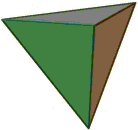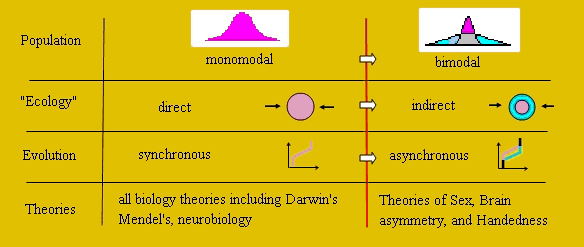 Can
you make 4 equilateral triangles with Can
you make 4 equilateral triangles with
6 toothpicks (they can't cross each other)?
This is 3-dimensional riddle which can not be
solved in 2-dimensions (tetrahedron)
Likewise, the problems of evolution can not be solved inside non
evolutionary branches of science that deal with small time
periods. Therefore any attempts to solve riddles of
asymmetry from embryology, pathology or the anomalies of
development point of view as well as attempts to solve
problem of sex as reproductive are destined to failure.
What such different
phenomena as female - male sex, right- - left brain hemispheres, right- -
left-handed people, DNA - proteins, and autosomes - sex chromosomes have in
common?
All
of them are 2 forms (phases) created in the process of evolution
from their respective unitary systems— population, brain, society etc.
Increasing variety of the unitary system elements transforms those
systems into binary ones consisting of conservative and operative
subsystems. First members (conservative subsystems) of the listed pairs
are responsible for the system preservation, second ones (operative
subsystems) — for its change.
All biological
theories, including main
paradigms
classical genetics and Darwinism, are by default theories for
unitary
systems. When these theories attempt to explain behavior of
binary
systems, they treat their subsystems as different forms, but not as
phases, therefore they lack one dimension. This is why we have so many
riddles.
This means that the
paradigm should be changed.
Increased variety
and therefore more close contact of the operative subsystems with the
environment transforms monomodal population into bimodal, direct
“ecology” (environment
→
system) into
indirect one (environment
→
operative
→
conservative subsystem)
and synchronous
evolution into asynchronous
(first operative then conservative subsystems). Appropriate theories are
required for their description.
Binary conjugated systems need theories
of bimodal populations,
indirect “ecology” and asynchronous evolution

The Evolutionary Theory of Sex
Summary
Applications:
Medicine
Anthropology
Theories of Asymmetrization of Organisms, Brain
and Body
Summary
Set of theories based on the
Asynchronous Evolution Principle:
Summary
Recent discussions, articles, books
|


